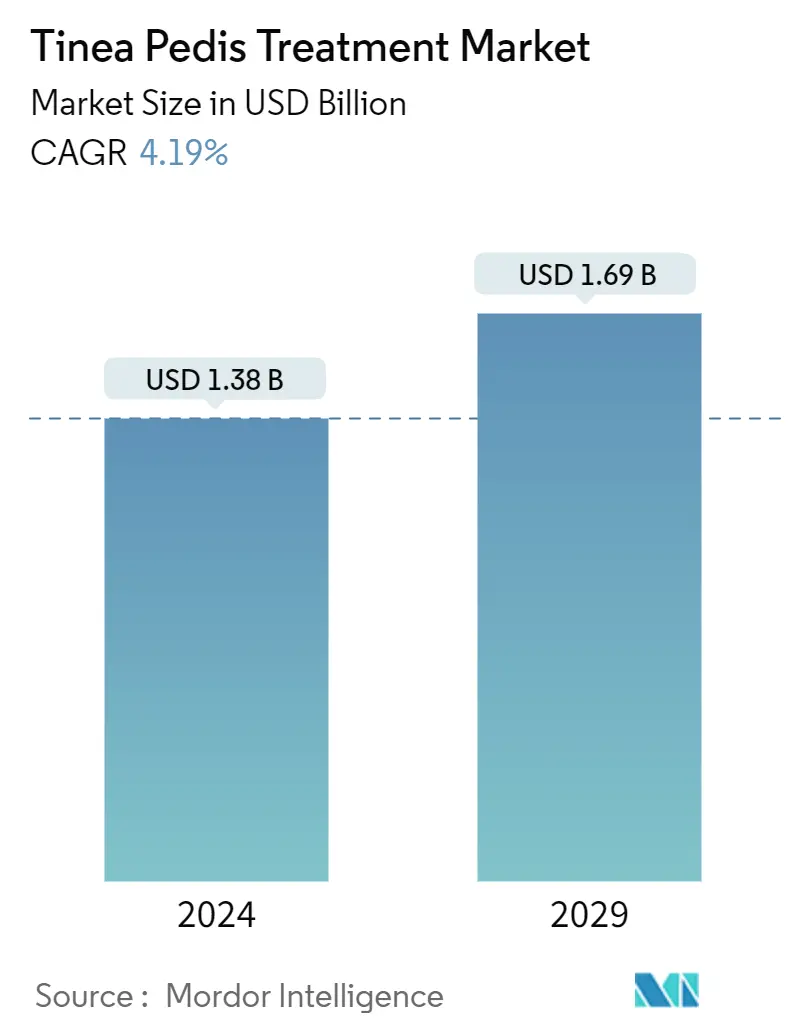Market Size of Tinea Pedis Treatment Industry

| Study Period | 2019 - 2029 |
| Market Size (2024) | USD 1.38 Billion |
| Market Size (2029) | USD 1.69 Billion |
| CAGR (2024 - 2029) | 4.19 % |
| Fastest Growing Market | Asia Pacific |
| Largest Market | North America |
| Market Concentration | Medium |
Major Players
*Disclaimer: Major Players sorted in no particular order |
Tinea Pedis Treatment Market Analysis
The Tinea Pedis Treatment Market size is estimated at USD 1.38 billion in 2024, and is expected to reach USD 1.69 billion by 2029, growing at a CAGR of 4.19% during the forecast period (2024-2029).
During the COVID-19 pandemic, the demand for tinea pedis treatment drugs rose due to increasing concerns about the mortality of patients with COVID-19. Fungal comorbidities in COVID-19 lead to higher mortalities compared to COVID-19 patients without these comorbidities. For instance, according to an article published by Nature Microbiology in August 2022, COVID-19-associated invasive fungal infections were a significant complication in a substantial number of critically ill, hospitalized patients. Hence, the COVID-19 pandemic affected the market significantly in its preliminary phase. However, as the pandemic has currently subsided, the studied market is expected to have stable growth over the forecast period of the study.
The major factor attributing to the growth of the market is the increase in the prevalence of fungal infections. Mycotic diseases are global in distribution, but the maximum cases are recorded from tropical and subtropical countries. As the number of patients increases, the market also grows. Furthermore, the increasing R&D programs and funding for the same are boosting the market growth.
For instance, according to an article updated by NCBI in July 2022, it is estimated that about 10% of the total population is affected by dermatophyte infections of the toe clefts. The most common reason for this is wearing occlusive shoes for long periods. The report also stated that the sharing of washing facilities is likely to increase the chances of infection as the incidence of tinea pedis is observed to be higher among those using community baths, showers, and pools. Tinea pedis is also said to be more common in adult males than in females. In addition to this, the rise in immunocompromised patients is also another factor that is expected to fuel market growth.
Furthermore, the increased R&D activities for the treatment of tinea pedis have been boosted by the rise in the prevalence rate of infectious disorders caused by bacteria, viruses, and fungi, which is driving the market. Around the world, anti-microbial research is gaining traction, and many companies have already initiated R&D activities, which is further expected to boost the growth of the studied market as fungal infections are also part of anti-microbial research activities. For instance, in August 2022, Forbion, announced the USD 70 million financing of F2G Ltd, a clinical-stage biopharmaceutical company focused on the discovery and development of novel therapies to treat life-threatening invasive fungal infections with a high unmet medical need.
Therefore, a rise in the prevalence of tinea pedis and a rise in research and development on fungal treatment, among others, are the factors expected to drive the market growth. However, the lack of awareness of the treatment and stringent approval regulations constrain the market growth.
Tinea Pedis Treatment Industry Segmentation
As per the scope of the report, tinea pedis (athlete's foot) is a fungal infection that usually begins between the toes. It commonly arises in people whose feet have become very sweaty while restricted within tight-fitting shoes. Tinea pedis is characterized by patchy, dry scaling on the feet and blisters or pustules on the feet and between the toes. The tinea pedis treatment market is segmented by route of administration, distribution channel, and geography. Based on route of administration the market is segmented as oral and topical. Based on distribution channels the market is segmented as hospital pharmacies, retail pharmacies, and e-commerce. Based on geography the market is segmented as North America, Europe, Asia-Pacific, Middle East and Africa, and South America). The report also covers the estimated market sizes and trends for 17 different countries across the major regions globally. The report offers the value (in USD) for the above segments.
| By Route of Administration | |
| Oral | |
| Topical |
| By Distribution Channel | |
| Hospital Pharmacies | |
| Retail Pharmacies | |
| E-commerce |
| Geography | ||||||||
| ||||||||
| ||||||||
| ||||||||
| ||||||||
|
Tinea Pedis Treatment Market Size Summary
The tinea pedis treatment market is poised for steady growth over the forecast period, driven by an increase in the prevalence of fungal infections globally, particularly in tropical and subtropical regions. The market's expansion is further supported by heightened research and development activities aimed at combating these infections, as well as the rising number of immunocompromised patients. The COVID-19 pandemic initially impacted the market by increasing the demand for treatments due to the complications arising from fungal comorbidities in infected patients. However, as the pandemic's effects have waned, the market is expected to stabilize and continue its growth trajectory. The development of novel therapies and the focus on antimicrobial research are key factors contributing to the market's positive outlook.
Topical treatments are anticipated to dominate the market segment due to their specific advantages, such as targeting the site of infection, reducing systemic side effects, and enhancing patient compliance. The availability of effective topical antifungal medications, like clotrimazole, and ongoing advancements in this area are expected to bolster segment growth. North America, particularly the United States, is projected to hold a significant market share, driven by a high prevalence of tinea pedis and robust healthcare infrastructure. The region's market growth is further supported by ongoing research and clinical trials aimed at developing new treatment formulations. The competitive landscape features major players like GlaxoSmithKline, Bausch Health, and Bayer AG, who are actively involved in advancing treatment options for tinea pedis.
Tinea Pedis Treatment Market Size - Table of Contents
-
1. MARKET DYNAMICS
-
1.1 Market Overview
-
1.2 Market Drivers
-
1.2.1 Increasing Prevalence of Fungal Infections
-
1.2.2 Rising Geriatric Population Around the World
-
-
1.3 Market Restraints
-
1.3.1 Lack of Awareness of Effective Treatment and Stringent Approval Regulations
-
-
1.4 Porter's Five Forces Analysis
-
1.4.1 Threat of New Entrants
-
1.4.2 Bargaining Power of Buyers/Consumers
-
1.4.3 Bargaining Power of Suppliers
-
1.4.4 Threat of Substitute Products
-
1.4.5 Intensity of Competitive Rivalry
-
-
-
2. MARKET SEGMENTATION (Market Size by Value - USD)
-
2.1 By Route of Administration
-
2.1.1 Oral
-
2.1.2 Topical
-
-
2.2 By Distribution Channel
-
2.2.1 Hospital Pharmacies
-
2.2.2 Retail Pharmacies
-
2.2.3 E-commerce
-
-
2.3 Geography
-
2.3.1 North America
-
2.3.1.1 United States
-
2.3.1.2 Canada
-
2.3.1.3 Mexico
-
-
2.3.2 Europe
-
2.3.2.1 Germany
-
2.3.2.2 United Kingdom
-
2.3.2.3 France
-
2.3.2.4 Italy
-
2.3.2.5 Spain
-
2.3.2.6 Rest of Europe
-
-
2.3.3 Asia-Pacific
-
2.3.3.1 China
-
2.3.3.2 Japan
-
2.3.3.3 India
-
2.3.3.4 Australia
-
2.3.3.5 South Korea
-
2.3.3.6 Rest of Asia-Pacific
-
-
2.3.4 Middle East and Africa
-
2.3.4.1 GCC
-
2.3.4.2 South Africa
-
2.3.4.3 Rest of Middle East and Africa
-
-
2.3.5 South America
-
2.3.5.1 Brazil
-
2.3.5.2 Argentina
-
2.3.5.3 Rest of South America
-
-
-
Tinea Pedis Treatment Market Size FAQs
How big is the Tinea Pedis Treatment Market?
The Tinea Pedis Treatment Market size is expected to reach USD 1.38 billion in 2024 and grow at a CAGR of 4.19% to reach USD 1.69 billion by 2029.
What is the current Tinea Pedis Treatment Market size?
In 2024, the Tinea Pedis Treatment Market size is expected to reach USD 1.38 billion.

